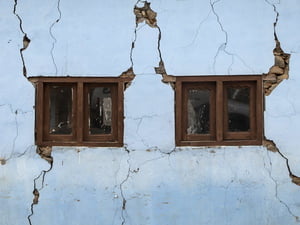
Tourism is the backbone of Nepal’s economy but has been struggling with the long-standing political instability and with natural disasters in each of the previous two years, including the 2015 earthquake whose anniversary is on April 25.
Nagarkot, Nepal (dpa) – Subba Tamang, his wife and two children have spent 11 months living in a corrugated metal shack after losing their home in the April 2015 earthquake.
In summer, the metal heats up and gives them headaches. In winter, moisture seeps into the bedclothes, causing them colds and fevers. The children have blisters on their faces from the harsh weather.
Tamang was working at a hotel in Nagarkot, on the outskirts of Kathmandu, when the earthquake struck. The hotel is intact, but his house, which was about an hour’s walk downhill, collapsed, killing his grandfather and his cattle.
For survivors, it has been a difficult year. The area’s lifeline of tourism has collapsed along with much of the infrastructure.
Hoteliers in the tourist hub of Nagarkot are struggling to make ends meet.
The number of arrivals has fallen by more than 50 per cent since the disaster. Some hotels have had no customers for months.
“This is supposed to be the high tourist season for us. But we hardly have guests. Not even Nepalis,” Tamang said.
Nagarkot used to be a popular destination for residents of the capital seeking a weekend out of the city.
A strong storm last month lifted the roof off Tamang’s shed, and the family doesn’t have enough money to put it back on.
Just outside the Sunshine Hotel where Subba Tamang works, a pack of dogs scavenges for food.
“They are so thin because they used to live on scraps thrown out by hotels. Now that there are hardly any guests to cook food for, there’s nothing to throw out for the dogs,” said Bishal Tamang, who runs a nearby tea stall.
Until last year, Tamang remembers making between 5,000 and 6,000 rupees (47-56 dollars) a day. Now, he barely makes 800 rupees.
“I’m thinking I should just close down my shop and go work in Kathmandu. In that crowded city, it might be possible to find some kind of work to make a living,” he said.
Bishal Tamang’s thoughts are echoed by Santosh Pokharel, 235 kilometres away in Pokhara, where he works in a restaurant as a waiter.
“Business has been so low this year,” he said. “My salary is so small, I basically survive on tips. If things don’t improve, I might have to pack my bags and head to the Gulf to work as a labourer.”
Nepal’s tourism industry has been hit by a series of disasters in the past few years.
In 2014, an avalanche on Mount Everest killed 16 Nepali climbers, leading to the cancellation of all expeditions. Blizzards that swept past the Annapurna Circuit that year killed at least 42 people, scaring many trekkers around the world off visiting Nepal.
In 2015, the country was struck by massive earthquakes in April and May, during the peak tourist season. Twenty people died in the Everest region, and the climbing season was called off again.
Nearly one year on, the tourism industry is staggering under the impact on visitor numbers, despite giving extensions to mountaineering permits granted for 2014 and 2015.
“We can tell you that the number of tourists visiting has gone down by 25 per cent,” Nepal Tourism Board spokesman Sarad Pradhan said.
Narabahadur Bika makes a living by ferrying tourists on the Fewa Lake in Pokhara.
“It was possible to make 1,000 rupees a day in the past during the tourist season. These days, we don’t even make a few hundred rupees a day,” he said.
Pokhara was not hit by the earthquake. Nevertheless, the lake town has seen a low tide of visitors, also owing to a six-month closure of the border by India that caused severe fuel shortages, stranding tourists or forcing them to pay exorbitant fares.
“If the political situation would get more stable, I’m sure Nepal can pick up even after the earthquake. But the politicians have been so busy fighting among themselves instead of thinking of how to lift the country back up from the calamity,” Bika said.
Minority groups in the southern region are demanding more autonomy. They managed to close the Indian border and block commerce for months to protest the new constitution. The political impasse remains.
Infrastructure damage has also hit the tourism sector. Heritage sites in the heart of Kathmandu lie in piles of rubble since the quakes.
[SOURCE:- DPA]



